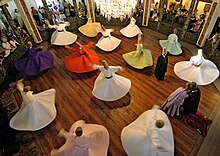Semah
The Semah or Sema (from Arabic samāʿ , "to hear") is an element of the trance dances in Sufi brotherhoods . Spiritual songs are played and sung at the Semah. Semah as a mystical performance is a remembrance of God brought about by music, song, dance and gestures. For the Alevis , the semah is one of the twelve duties in the Cem event, the spiritual gathering of the Alevis.
The music of the ritual dance is determined by the usul (rhythm / meter) aksak . The dancers alternate between slow and fast steps as well as between circular movements and movements directed towards the center. Rotary movements around their own axis are characteristic, with which a union of man with God and nature is sought. The palm of the right hand points upwards and the left palm towards the floor. Rotating in a circular path and around its own axis symbolizes the rotations of the planets in their orbit around the sun, but also the eternal cycles of life and nature. In addition, the dance and flight movements of the crane, holy to the Alevis (turkish turna ) are imitated while dancing .
The texts are about Allah , the Prophet Mohammed , his cousins Ali and Hızır , and about the people themselves: One should always believe in the good in people in order not to stray from the right path.
The Semah is also called the “crane dance ” ( turnalar semahi ) because the crane, which occurs frequently in Turkish folk tales, covers long distances between its homeland and distant regions and thus appears as a symbolic mediator between lovers and from people to God. The circular dance is a common and widely used motif with a magical meaning in premonotheistic ethnic religions. The symbol of the crane, which also occurs in Japanese mythology, refers to a connection to old Central Asian ideas, which are summarized as Tengrism .
Web links
Individual evidence
- ↑ The Semah . (Alevi Toplumu) Alevi Congregation Duisburg e. V.
- ↑ Mehmet Kara, Ersin Teres: The Crane as a Symbol of Fidelity in Turkish and Japanese Cultures. Millî Folklor, 2012, pp. 194–201, here pp. 196, 200

